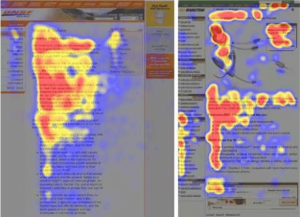They don’t.
 People rarely read web pages word by word; instead, they scan the page, picking out individual words and sentences. In research on how people read websites, it is found that 79% of readers always scanned any new page they came across and only 16% read word-by-word.
People rarely read web pages word by word; instead, they scan the page, picking out individual words and sentences. In research on how people read websites, it is found that 79% of readers always scanned any new page they came across and only 16% read word-by-word.
As a result, web pages have to employ scannable text, using:
- highlighted keywords (hypertext links serve as one form of highlighting; typeface variations and colour are others)
- meaningful sub-headings (not “clever” ones)
- bulleted lists
- one idea per paragraph (users will skip over any additional ideas if they are not caught by the first few words in the paragraph)
- the inverted pyramid style, starting with the conclusion
- half the word count (or less) than conventional writing
The research found that credibility is important for web users since it is unclear who is behind information on the web and whether a page can be trusted. Credibility can be increased by high-quality graphics, good writing, and use of outbound hypertext links. Links to other sites show that the authors have done their homework and are not afraid to let readers visit other sites.
Even if you have spent a lot of time and effort composing copy, your online readers will invariably prefer to just scan what you have written. Even the people who read online articles are given to scanning a page instead of fully and thoroughly reading the copy word for word.
This lack of commitment to reading copy fully can be explained in one of three ways:
- Readers are simply in a hurry because users on the Internet are motivated by trying to save time
- Readers understand perfectly well that they don’t really have to read everything because, usually, they are just searching for what’s personally relevant to them or what can help them achieve the task they are pursuing
- Readers are already so well-trained in scanning pages from years and years of scanning print (newspapers, magazines, textbooks, novels, etc.) that they are used to it and good at it
How to Write for People Reading on the Web
Now that I have explained how your customers actually read on the web, I am going to give you some recommendations on how to specifically write for them. After all, your time is precious, and so is theirs.
People detest “marketese”; the promotional writing style with boastful subjective claims (“hottest ever”) that currently is prevalent on the Web. Web users are busy and they want to get the straight facts. Also, credibility suffers when users clearly see that the site exaggerates.
Websites must combine all the writing styles below to increase usability:
- Promotional writing
- Concise text
- Structure in a scannable layout
- Use Objective language
Place the Most Important Stuff in the Top Left Corner
 This recommendation ties into the research finding that people on the Internet mainly read pages in an F-shaped pattern. When people start reading in this pattern, they begin in the top, left corner of a page since the top bar of the F begins in that area.
This recommendation ties into the research finding that people on the Internet mainly read pages in an F-shaped pattern. When people start reading in this pattern, they begin in the top, left corner of a page since the top bar of the F begins in that area.
Put important information in your copy in this portion of the page and chances are greater than ever that they won’t ignore or miss it.
Conclusion
People’s reading habits on the web are very different than their reading habits when they have a book, magazine or newspaper in their hands. This means that you have to tailor your websites written content—landing page copy, blog posts, etc.—to the unique and sometimes unexpected behaviour of online readers. Failure to do so means a low-converting website, which is what you want to avoid at all costs.
Writing web copy doesn’t mean that you have to be the best and most literate wordsmith around. On the contrary: It means knowing exactly who your audience is on the Internet and what they expect. Thus, you have to present them with nothing but highly relevant, chunked content that’s properly placed on a page, with regard to eye-tracking studies’ findings. Do this, and more readers will pay attention to your content.
Did you scan this post?
I would be interested to know how much of this post you actually read, or alternatively how much of other blogs/web pages you usually read in general.
Please let me know in the comments.



